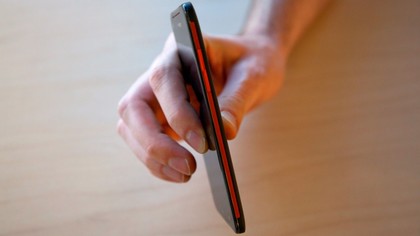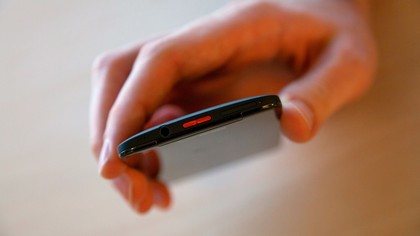TechRadar Verdict
Pros
- +
Seriously beefy specs
- +
First-rate camera
- +
Great display
- +
Runs Jelly Bean very well
- +
Nice price
Cons
- -
HTC's UI is a bit tacky
- -
No removable storage, only 16GB internal
- -
Difficult to use with one hand
- -
Mediocre battery life
Why you can trust TechRadar
Update: Probably because the HTC One on Verizon is coming soon, the Droid DNA is now just $50 with two-year contract.
The Droid DNA by HTC is a big phone with a long name. Droid is Verizon's brand, but HTC has constructed a slick looking device with enviable specs and a mammoth high-resolution display.
It also runs Android 4.1: Jelly Bean, making it the second HTC phone to launch with this version of the Android OS, next to the HTC One X+.
It's big, powerful and loaded with relevant software, and even priced to move. The Droid DNA is only $199 with new Verizon contract. Not bad for a brand new quad-core device.
In addition to the Droid's good looks, it has the brilliant display and snappy camera HTC phones are known for. Sadly, its also got some of the HTC turn-offs, like a closed body without microSD support, just 16GB of storage inside, and a battery that often struggled to make it through the day.
A few qualms aside, we're prepared to say that there's still a lot to love about the Droid DNA. With butt-kicking hardware, a knockout screen, fast Verizon service and a nice price, it's a very good phone on a solid carrier. Still, it's a pity to see a device with such meaty specs come up short of true greatness.
Design
Remember when a little phone signified a premium handset? Well the Droid DNA confirms that those days are over - for now, at least. Measuring in at 5.6-inches tall and 2.7-inches wide, the DNA is a real beast of a device.
Sign up for breaking news, reviews, opinion, top tech deals, and more.
It's tall and relatively slim, measuring 0.38-inches at its thickest. That makes it a little bit fatter than a Samsung Galaxy S3 or fellow Verizon exclusive the Droid Razr HD, but you really need to go side by side to tell.

The Droid DNA is a big boy, but there's not really any wasted space. This phone packs a whopping 5-inch display. For pure visual real estate, it edges out the Galaxy S3 and the Droid Razr HD, both of which come in at 4.8 and 4.7-inches, respectively.
The screen is built with Gorilla Glass, as is nearly every phone on the market these days. However, the Droid DNA has no bezel wrapped around the edge of its screen. Instead, the display rounds and curves at the edges, meeting the chassis to form a particularly smooth-featured device.
Below that monolithic super LCD3 screen are three capacitive Android buttons: Back, Home and Recent Apps. Each provides light, springy haptic feedback when touched.

Aesthetically, the Droid DNA looks somewhat sci-fi. With its matte black finish and red, aerated racing stripes, it wouldn't look out of place on the helm of the "Prometheus," or poking out of Noomi Rapace's space suit.

That red line look extends to the primary call speaker at the top. Inset within that there's a little light that glows when the phone is charging. This is handier than you'd think, since the Droid DNA supports wireless charging. It serves as a nice confirmation that the phone is getting juice without having to wake the screen.

To the left of the call speaker is a circular notification light, which glows orange. To the right of that is a Verizon logo. The DNA, like all Droid phones, is exclusive to Verizon.
At the very top of the handset you'll find the standard headphone jack and a red Sleep/Wake button. There's also a micro-SIM card slot up there.

On the right side is a shiny red volume rocker. The left features nothing but a metallic red line.
The overall construction of the Droid DNA is very smooth and glassy. It definitely has a premium feel that will appeal to anyone turned off by the more plastic-feeling phones (ahem, Galaxy S3). It maintains a very tight profile thanks to its sunken Sleep/Wake button and volume rocker.
However, the switches on the Droid DNA are so flush they can be a bit of work to find and press. To operate them, we needed a better grip on the DNA than on other phones with more pronounced features.
Though this is not a slippery handset, thanks to a soft-touch polycarbonate backing. This is the DNA at its most HTC-tastic, with a feel that's reminiscent of the HTC One X, One X+ and Windows Phone 8X, other phones from the self-proclaimed "Quietly Brilliant" brand.
As is the case with many HTC phones, it's a completely sealed design. That means no removable battery or microSD slot. This is a bit of problem, since internal storage is only 16GB.
Also on the rear are the requisite still and video lenses, the first of which is ringed in the DNA's signature red metal. There's also a rear notification light, something we've never seen before. Hidden beneath the black finish, it's only detectable when it glows orange to let you know you've missed a text, email or call.

There's also branding for Dr. Dre's Beats Audio. It claims boosted audio performance for headphones, and the sound is certainly better with it activated, but we're not sure it does any better than the iPhone 5's equalizer.
Dre's Beats do nothing for the phone's external speaker, which is found low on the DNA's backside, and is plenty loud anyway.
While that rubbery rear grip means the Droid DNA won't go flying out of your hand too easily, there is the larger issue of the phone's massive size. Even those with big hands may find it difficult to operate with just five digits. When locking the phone, we often found ourselves bracing the DNA on the bottom with one hand while we locked it with the other, and we have pretty big hands.
The size of this handset is by no means a poor choice on the part of HTC, it just comes down to personal preference and what you want out of a phone. If you want a smartphone built for media consumption plus web browsing and squint-free reading, the DNA should be on your radar. If you want a device that fits easily in the palm, that you can pop in a pocket and forget about, maybe go down a few inches.
